Evolutionary Games and Population Dynamics/Well-mixed populations: Difference between revisions
No edit summary |
mNo edit summary |
||
| Line 13: | Line 13: | ||
{{-}} | {{-}} | ||
== Evolutionary scenarios == | == Evolutionary scenarios == | ||
All of the following examples and suggestions are meant as inspirations for further experimenting with the '' | All of the following examples and suggestions are meant as inspirations for further experimenting with the ''EvoLudo'' simulator. Each of following examples starts a lab that demonstrates the particular dynamical scenario. By modifying the [[Parameters|parameters]] the dynamics can be further explored. | ||
{{Legend:PlainAB}} | {{Legend:PlainAB}} | ||
| Line 19: | Line 19: | ||
<div class="lab_description EcoPGG"> | <div class="lab_description EcoPGG"> | ||
[[Image:Well-mixed Ecological PGG - no Q, extinction.png |left|200px]] | [[Image:Well-mixed Ecological PGG - no Q, extinction.png |left|200px]] | ||
==== [[ | ==== [[EvoLudoLab: Ecological Public Goods Game - No Q, extinction|(a) No ''Q'', extinction]]==== | ||
No matter what the initial configuration of the cooperators and defectors, the population will invariably go extinct. | No matter what the initial configuration of the cooperators and defectors, the population will invariably go extinct. | ||
| Line 28: | Line 28: | ||
<div class="lab_description EcoPGG"> | <div class="lab_description EcoPGG"> | ||
[[Image:Well-mixed Ecological PGG - unstable node.png |left|200px]] | [[Image:Well-mixed Ecological PGG - unstable node.png |left|200px]] | ||
==== [[ | ==== [[EvoLudoLab: Ecological Public Goods Game - Unstable node|(b) Unstable node]]==== | ||
The presence of the interior fixed point <math>Q</math> does not affect the evolutionary end state of the system - the population keeps going extinct irrespective of the initial conditions. | The presence of the interior fixed point <math>Q</math> does not affect the evolutionary end state of the system - the population keeps going extinct irrespective of the initial conditions. | ||
| Line 37: | Line 37: | ||
<div class="lab_description EcoPGG"> | <div class="lab_description EcoPGG"> | ||
[[Image:Well-mixed Ecological PGG - unstable focus.png |left|200px]] | [[Image:Well-mixed Ecological PGG - unstable focus.png |left|200px]] | ||
==== [[ | ==== [[EvoLudoLab: Ecological Public Goods Game - Unstable focus|(c) Unstable focus]]==== | ||
For larger <math>r</math>, the interior fixed point <math>Q</math> turns into an unstable focus and - depending on the initial conditions - the population faces extinction in an oscillatory manner. | For larger <math>r</math>, the interior fixed point <math>Q</math> turns into an unstable focus and - depending on the initial conditions - the population faces extinction in an oscillatory manner. | ||
| Line 46: | Line 46: | ||
<div class="lab_description EcoPGG"> | <div class="lab_description EcoPGG"> | ||
[[Image:Well-mixed Ecological PGG - stable limit cycle.png |left|200px]] | [[Image:Well-mixed Ecological PGG - stable limit cycle.png |left|200px]] | ||
==== [[ | ==== [[EvoLudoLab: Ecological Public Goods Game - Stable limit cycle|Stable limit cycle - super-critical Hopf bifurcation]]==== | ||
For slightly higher <math>r</math> the interior fixed point <math>Q</math> is still an unstable focus but now surrounded by a stable limit cycle - the hallmark of a super critical Hopf bifurcation. Cooperators and defectors co-exist in never ending periodic oscillations. | For slightly higher <math>r</math> the interior fixed point <math>Q</math> is still an unstable focus but now surrounded by a stable limit cycle - the hallmark of a super critical Hopf bifurcation. Cooperators and defectors co-exist in never ending periodic oscillations. | ||
| Line 55: | Line 55: | ||
<div class="lab_description EcoPGG"> | <div class="lab_description EcoPGG"> | ||
[[Image:Well-mixed Ecological PGG - stable focus.png |left|200px]] | [[Image:Well-mixed Ecological PGG - stable focus.png |left|200px]] | ||
==== [[ | ==== [[EvoLudoLab: Ecological Public Goods Game - Stable focus|(d) Stable focus]]==== | ||
Increasing <math>r</math> further leads to a Hopf bifurcation, the interior fixed point <math>Q</math> becomes a stable focus and the limit cycle disappears. Depending on the initial conditions, cooperators and defectors co-exist at some fixed densities. If exploitation by defectors is severe or population densities are too low, the population is unable to recover and goes extinct. | Increasing <math>r</math> further leads to a Hopf bifurcation, the interior fixed point <math>Q</math> becomes a stable focus and the limit cycle disappears. Depending on the initial conditions, cooperators and defectors co-exist at some fixed densities. If exploitation by defectors is severe or population densities are too low, the population is unable to recover and goes extinct. | ||
{{-}} | {{-}} | ||
| Line 62: | Line 62: | ||
<div class="lab_description EcoPGG"> | <div class="lab_description EcoPGG"> | ||
[[Image:Well-mixed Ecological PGG - stable node.png |left|200px]] | [[Image:Well-mixed Ecological PGG - stable node.png |left|200px]] | ||
==== [[ | ==== [[EvoLudoLab: Ecological Public Goods Game - Stable node|(e) Stable node]]==== | ||
Another increase in <math>r</math> turns the interios fixed point <math>Q</math> into a stable node. As before, cooperators and defectors co-exist at some fixed densities only, they no longer approach the equilibrium in an oscillatory manner. Severe exploitation and low population densities again result in extinction. | Another increase in <math>r</math> turns the interios fixed point <math>Q</math> into a stable node. As before, cooperators and defectors co-exist at some fixed densities only, they no longer approach the equilibrium in an oscillatory manner. Severe exploitation and low population densities again result in extinction. | ||
{{-}} | {{-}} | ||
| Line 70: | Line 70: | ||
[[Image:Well-mixed Ecological PGG - no Q, cooperation.png |left|200px]] | [[Image:Well-mixed Ecological PGG - no Q, cooperation.png |left|200px]] | ||
==== [[ | ==== [[EvoLudoLab: Ecological Public Goods Game - No Q, cooperation |(f) No ''Q'', cooperation]]==== | ||
For high <math>r</math>, the interior fixed point <math>Q</math> disappears and the high density saddle node along <math>f=1</math>, i.e. in absence of defectors, becomes a stable equilibrium. Cooperators and defectors can no longer co-exist but now its only the defectors that disappear, at least for favorable initial conditions. As always, severe exploitation and low population densities result in extinction. | For high <math>r</math>, the interior fixed point <math>Q</math> disappears and the high density saddle node along <math>f=1</math>, i.e. in absence of defectors, becomes a stable equilibrium. Cooperators and defectors can no longer co-exist but now its only the defectors that disappear, at least for favorable initial conditions. As always, severe exploitation and low population densities result in extinction. | ||
{{-}} | {{-}} | ||
| Line 83: | Line 83: | ||
<div class="lab_description EcoPGG"> | <div class="lab_description EcoPGG"> | ||
[[Image:Well-mixed Ecological PGG - Bautin.png |left|200px]] | [[Image:Well-mixed Ecological PGG - Bautin.png |left|200px]] | ||
==== [[ | ==== [[EvoLudoLab: Ecological Public Goods Game - Bautin|Multiple limit cycles - Bautin bifurcation]]==== | ||
In this example, for <math>N=12</math>, a stable and an unstable limit cycle exist on one side of the Hopf bifurcation and another stable limit cycle on the other side. | In this example, for <math>N=12</math>, a stable and an unstable limit cycle exist on one side of the Hopf bifurcation and another stable limit cycle on the other side. | ||
| Line 92: | Line 92: | ||
<div class="lab_description EcoPGG"> | <div class="lab_description EcoPGG"> | ||
[[Image:Well-mixed Ecological PGG - unstable limit cycle.png |left|200px]] | [[Image:Well-mixed Ecological PGG - unstable limit cycle.png |left|200px]] | ||
==== [[ | ==== [[EvoLudoLab: Ecological Public Goods Game - Unstable limit cycle|Unstable limit cycle - sub-critical Hopf bifurcation]]==== | ||
In the special case <math>b=0</math> sub-critical Hopf-bifurcations always seem to give rise to a pair of stable and unstable limit cycles (Bautin bifurcation). Apparently only for <math>b>0</math> a simple sub-critical Hopf-bifurcation can be observed. | In the special case <math>b=0</math> sub-critical Hopf-bifurcations always seem to give rise to a pair of stable and unstable limit cycles (Bautin bifurcation). Apparently only for <math>b>0</math> a simple sub-critical Hopf-bifurcation can be observed. | ||
{{-}} | {{-}} | ||
Revision as of 15:24, 26 January 2010
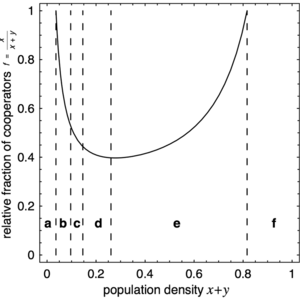
In a population of varying density, an attempt at gathering [math]\displaystyle{ N }[/math] individuals that engage in a public goods interaction might not always be successful at low population densities and instead of a group of size [math]\displaystyle{ N }[/math], only [math]\displaystyle{ S\leq N }[/math] individuals participate. If [math]\displaystyle{ S=0 }[/math] or [math]\displaystyle{ S=1 }[/math] no interaction occurs. This leads to a natural feedback between population density and game theoretical interactions. The dynamics of cooperators and defectors in public goods interactions is determined by their respective payoffs obtained in randomly formed groups of [math]\displaystyle{ S }[/math] individuals. Independent of whether the focal individual is a cooperator or a defector, it receives the same expected payoff from its [math]\displaystyle{ S-1 }[/math] co-players. Hence, the sole determinant of success is the return of the individual's own investment [math]\displaystyle{ c }[/math], which is [math]\displaystyle{ (r/S - 1) c }[/math]. For [math]\displaystyle{ 1\lt r\lt S }[/math] defectors are always better off as required by the traditional formulation of the public goods game. However, for [math]\displaystyle{ r\gt S }[/math] the social dilemma is relaxed and cooperation dominates. Nevertheless, defectors outperform cooperators in any group consisting of both types (this represents an instance of Simpson's paradox). Also note that this is a fleeting state since thriving cooperators increases the average population payoff and hence the population density which in turn leads to larger interaction groups and puts defectors back into control.
The negative feedback between population density and interaction group size hinges on the fact that the group size can become smaller than [math]\displaystyle{ r }[/math]. For pairwise prisoner's dilemma interactions this is not the case: because [math]\displaystyle{ S }[/math] cannot vary (and is always equal to [math]\displaystyle{ N=2 }[/math]), either [math]\displaystyle{ r\lt S }[/math] always holds (in which case the population goes extinct) or [math]\displaystyle{ r\gt S }[/math] always holds (in which case defectors disappear but cooperators persist). The dynamic feedback cannot operate in either case.
The following figures and simulations illustrate the rich dynamics of this system. For increasing [math]\displaystyle{ r }[/math] the system undergoes a series of bifurcations. A super-critical or sub-critical Hopf bifurcation gives rise to stable and unstable limit cycles, respectively, and a Bautin bifurcation may even result in a pair of stable and unstable limit cycles that collide and disappear in a saddle-node bifurcation of periodic orbits.
The phase space is spanned by the population density [math]\displaystyle{ x + y }[/math] (or [math]\displaystyle{ 1 - z }[/math]) and the relative fraction of cooperators [math]\displaystyle{ f = x / (x + y) }[/math]. The left boundary ([math]\displaystyle{ z = 1 }[/math]) is attracting and consists of a line of stable fixed points (filled circles), which represent states where the population cannot maintain itself and disappears. Conversely, the right boundary, which denotes the maximal population density ([math]\displaystyle{ z = 0 }[/math]), is repelling. In absence of cooperators (bottom boundary, [math]\displaystyle{ f = 0 }[/math]), population densities decrease and eventually vanish. Finally, in absence of defectors (top boundary, [math]\displaystyle{ f = 1 }[/math]), there are two saddle points (open circles) except for the last scenario where one is a stable node (filled circle). In addition, there may be an interior fixed point [math]\displaystyle{ Q }[/math] present.
Evolutionary scenarios
All of the following examples and suggestions are meant as inspirations for further experimenting with the EvoLudo simulator. Each of following examples starts a lab that demonstrates the particular dynamical scenario. By modifying the parameters the dynamics can be further explored.
| Color code: | Cooperators | Defectors |
|---|

(a) No Q, extinction
No matter what the initial configuration of the cooperators and defectors, the population will invariably go extinct.
Hint: start from different initial configurations to get a better intuition of the dynamics.

(b) Unstable node
The presence of the interior fixed point [math]\displaystyle{ Q }[/math] does not affect the evolutionary end state of the system - the population keeps going extinct irrespective of the initial conditions.
Hint: backwards intergration reveals the location of the unstable node when starting in a suitable part of the phase plane.
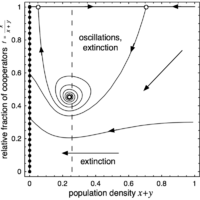
(c) Unstable focus
For larger [math]\displaystyle{ r }[/math], the interior fixed point [math]\displaystyle{ Q }[/math] turns into an unstable focus and - depending on the initial conditions - the population faces extinction in an oscillatory manner.
Hint: backwards intergration reveals the location of the unstable focus when starting in a suitable part of the phase plane.
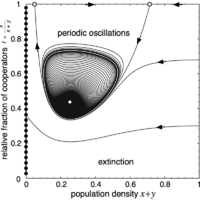
Stable limit cycle - super-critical Hopf bifurcation
For slightly higher [math]\displaystyle{ r }[/math] the interior fixed point [math]\displaystyle{ Q }[/math] is still an unstable focus but now surrounded by a stable limit cycle - the hallmark of a super critical Hopf bifurcation. Cooperators and defectors co-exist in never ending periodic oscillations.
Hint: often, the forward integration will not stop and keep tracking the stable limit cycle. Just click on the phase plane to stop forward integration and start the backward integration. Another click stops backward integration, too.
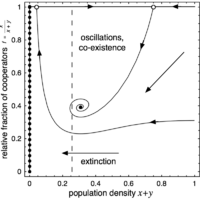
(d) Stable focus
Increasing [math]\displaystyle{ r }[/math] further leads to a Hopf bifurcation, the interior fixed point [math]\displaystyle{ Q }[/math] becomes a stable focus and the limit cycle disappears. Depending on the initial conditions, cooperators and defectors co-exist at some fixed densities. If exploitation by defectors is severe or population densities are too low, the population is unable to recover and goes extinct.

(e) Stable node
Another increase in [math]\displaystyle{ r }[/math] turns the interios fixed point [math]\displaystyle{ Q }[/math] into a stable node. As before, cooperators and defectors co-exist at some fixed densities only, they no longer approach the equilibrium in an oscillatory manner. Severe exploitation and low population densities again result in extinction.
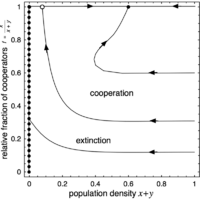
(f) No Q, cooperation
For high [math]\displaystyle{ r }[/math], the interior fixed point [math]\displaystyle{ Q }[/math] disappears and the high density saddle node along [math]\displaystyle{ f=1 }[/math], i.e. in absence of defectors, becomes a stable equilibrium. Cooperators and defectors can no longer co-exist but now its only the defectors that disappear, at least for favorable initial conditions. As always, severe exploitation and low population densities result in extinction.
Complex bifurcations
For larger group sizes [math]\displaystyle{ N }[/math] fascinating and much more complex Hopf bifurcations and dynamical scenarios are possible, which includes multiple, stable and unstable limit cycles. However, also note that r values for which these fascinating bifurcations occur is restricted to a tiny interval. Thus, despite their appeal from a dynamical systems' perspective, the limit cycles might be of only limited relevance for biological applications.
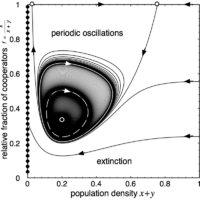
Multiple limit cycles - Bautin bifurcation
In this example, for [math]\displaystyle{ N=12 }[/math], a stable and an unstable limit cycle exist on one side of the Hopf bifurcation and another stable limit cycle on the other side.
Hint: Try lowering [math]\displaystyle{ r }[/math] slightly to just below the Hopf-bifurcation (set [math]\displaystyle{ r = 3.04 }[/math]). The interior fixed point [math]\displaystyle{ Q }[/math] is now an unstable focus surrounded by a stable limit cycle (see above).

Unstable limit cycle - sub-critical Hopf bifurcation
In the special case [math]\displaystyle{ b=0 }[/math] sub-critical Hopf-bifurcations always seem to give rise to a pair of stable and unstable limit cycles (Bautin bifurcation). Apparently only for [math]\displaystyle{ b\gt 0 }[/math] a simple sub-critical Hopf-bifurcation can be observed.
Population Dynamics
In order to combine game dynamics and population dynamics in a replicator equation we assume that [math]\displaystyle{ x }[/math] denotes the density of cooperators, [math]\displaystyle{ y }[/math] the density of defectors and [math]\displaystyle{ z=1-x-y }[/math] the abundance of empty space. Thus, [math]\displaystyle{ x+y }[/math] denotes a normalized population density such that for [math]\displaystyle{ x+y=0 }[/math] (or [math]\displaystyle{ z=1 }[/math]) the population has gone extinct. The dynamics of [math]\displaystyle{ x, y }[/math] and [math]\displaystyle{ z }[/math] is determined by the average payoffs (or fitness) of cooperators [math]\displaystyle{ f_C }[/math] and defectors [math]\displaystyle{ f_D }[/math]arising from game theoretical interactions. Cooperators and defectors are assumed to die at a constant rate [math]\displaystyle{ d }[/math] and give birth according to a constant baseline birth rate [math]\displaystyle{ b }[/math] augmented by their performance [math]\displaystyle{ f_C }[/math] and [math]\displaystyle{ f_D }[/math]. In addition, birth events are conditional on the availability of empty space and hence are proportional to [math]\displaystyle{ z }[/math]. This leads to the following population dynamic model:
- [math]\displaystyle{ \dot x = x (z (b+f_C)-d) }[/math]
- [math]\displaystyle{ \dot y = y (z (b+f_D)-d) }[/math]
- [math]\displaystyle{ \dot z = -\dot x -\dot y }[/math]
This system of equations represents a natural extension of the replicator dynamics. If the population density [math]\displaystyle{ x+y }[/math] is kept constant ([math]\displaystyle{ \dot z = 0 }[/math]) by adjusting the death rate accordingly, i.e. by setting [math]\displaystyle{ d = z(b+\bar f/(1-z)) }[/math], where [math]\displaystyle{ \bar f = x f_C+y f_D }[/math] denotes the mean fitness, the traditional replicator dynamics is recovered (upon normalizing [math]\displaystyle{ x+y=1 }[/math]). The average payoffs [math]\displaystyle{ f_C }[/math] and [math]\displaystyle{ f_D }[/math]are determined by the actual game theoretical interactions under consideration.
Payoffs of cooperators and defectors
In a population with a fraction [math]\displaystyle{ x }[/math] cooperators, [math]\displaystyle{ y }[/math] defectors and [math]\displaystyle{ z = 1 - x - y }[/math] available space, then the average payoff to cooperators [math]\displaystyle{ f_C }[/math] and defectors [math]\displaystyle{ f_D }[/math] is given by:
- [math]\displaystyle{ f_D = r \frac x{1 - z} (1 - \frac{1 - z^N}{N (1 - z)}) }[/math]
- [math]\displaystyle{ f_C = f_D - F(z) }[/math]
with
- [math]\displaystyle{ F(z) = 1 + (r - 1) z^{N - 1} - r \frac{1 - z^N}{N (1 - z)}. }[/math]
Note that this ivation assumes that the benefits of the public good is contingent on social interactions, i.e. a single participant in the public goods interaction cannot increase its capital. For a detailed derivation of the formulas please consult the scientific articles in the reference section.